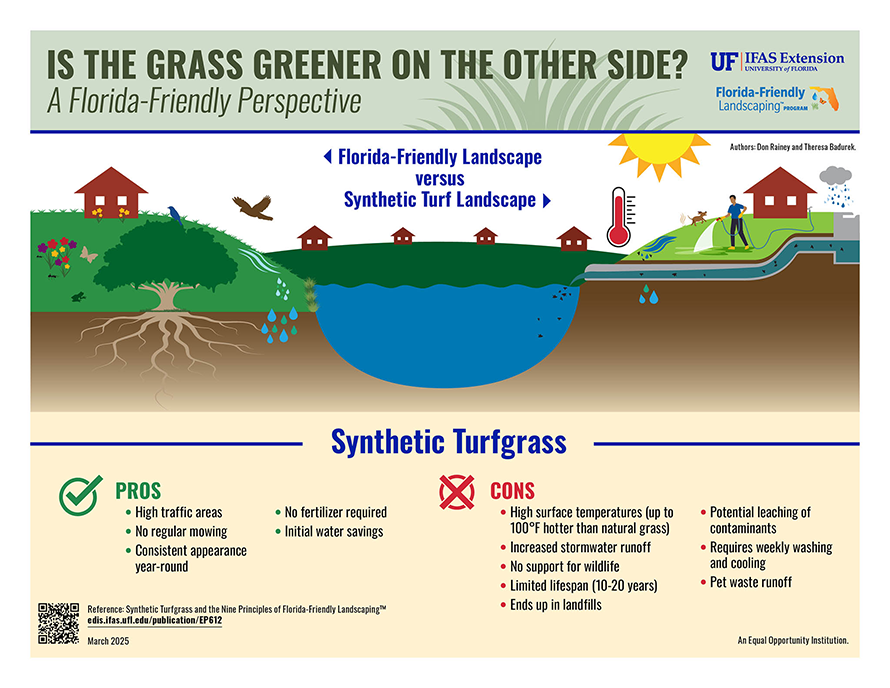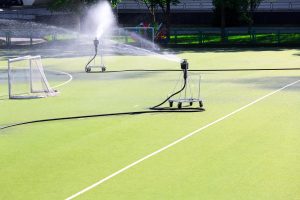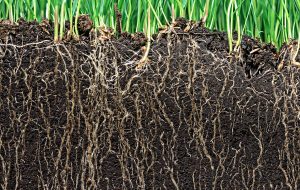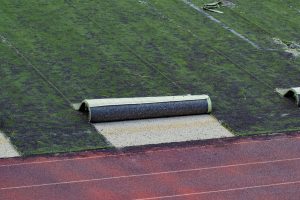There are a lot of factors to consider when picking a variety of turfgrass for your yard. How much sun does your yard get? What is the pH of your soil? Will there be heavy foot traffic?
When there isn’t a one-size-fits-all solution to turfgrass selection, people will sometimes consider a synthetic alternative. But is “artificial grass” or “synthetic turf” environmentally friendly? Let’s look a few Florida-Friendly Landscaping™ principles and see how they apply to artificial grass.
Artificial grass was originally invented as a low-maintenance playground surface. Essentially, an outdoor carpet that imitates the look of natural turf, synthetic turf does not provide the ecosystem benefits of a natural turf system.

Right Plant, Right Place
- Artificial grass is not alive, so it is not a suitable plant choice for a landscape. Natural turf plays an important part in cooling the environment. Artificial grass holds heat and is much hotter than natural turf. Living turf has a root system, which helps filter and slow runoff and stop erosion. Artificial grass requires soil compaction for installation and increases runoff.
Water Efficiently

- While artificial grass doesn’t need regular watering to stay green, it often needs to be sprayed down to cool it off. Synthetic turf can reach up to 160°F. It also requires weekly washdowns to remove dust, pet waste, and odors. Beyond water use, artificial grass creates a hard, compact surface that doesn’t soak in rain. Instead, water runs off, much like it would on a sidewalk or driveway, whereas living turf has roots that help filter water, slow runoff, and prevent erosion—especially around lakes, ponds, or other water bodies. These natural systems play a big role in keeping our waterways clean and healthy.
Fertilize Appropriately
- The root system in turfgrass plays an important role in filtering water. While artificial grass doesn’t need fertilization, it also doesn’t offer the same environmental benefit.
Attract Wildlife
- A healthy lawn supports beneficial insects like beetles, bees, and worms, which in turn provide food for birds and other ground-feeding animals. Supporting wildlife is an important part of a healthy ecosystem. Artificial grass, however, doesn’t offer any benefits for attracting or supporting wildlife.
Recycle Yard Waste
- Leaving grass clippings on your lawn is a simple, effective way to recycle yard waste. As they break down, they return nutrients to the soil- essentially acting as free fertilizer, whereas artificial grass doesn’t provide natural yard waste and has a limited lifespan of 10-20 years. Once it wears out, the plastic material often ends up in a landfill.
Artificial grass is counter to the sustainability goals of the Florida-Friendly Landscaping™ Program.
If you are having trouble with your lawn and considering artificial grass, groundcover may be an appropriate alternative. Check out the Lawn Ornament Blog Series to learn more.
Resources:
https://edis.ifas.ufl.edu/topics/turfgrasses
https://edis.ifas.ufl.edu/PUBLICATION/EP612
Blog was co-written by: Jody Breaud, Orange County Master Gardener Volunteer, and Clarissa Chairez, UF/IFAS Extension Orange County Master Gardener Volunteer Coordinator
 6
6


